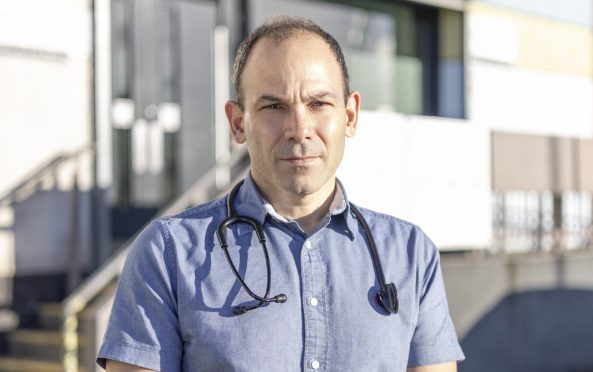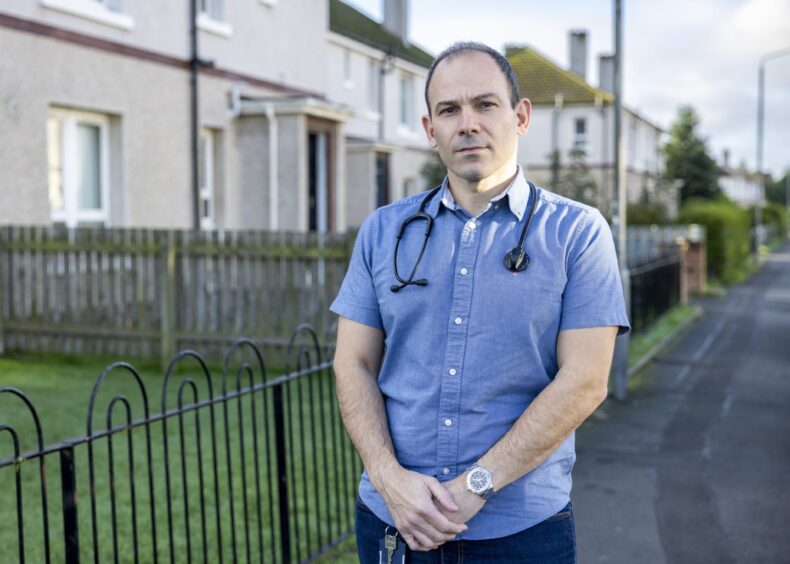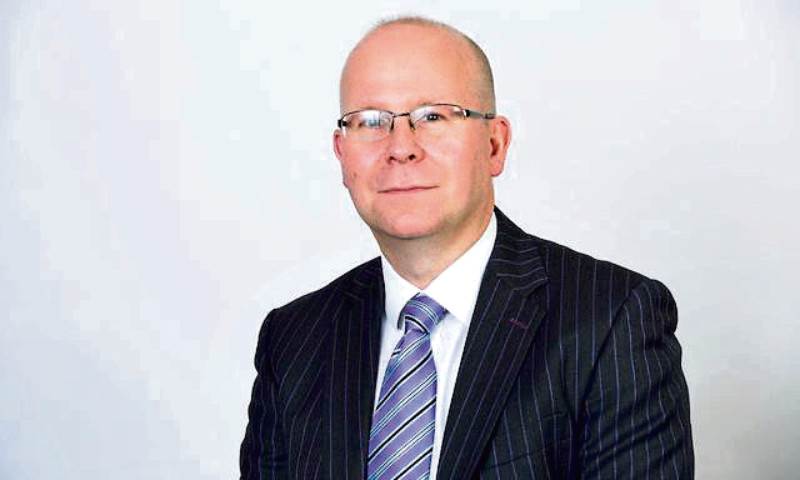
The intense pressure faced by Scotland’s family doctors as they struggle with rising patient numbers is laid bare today.
GP Dr Jimmy Khouly has chosen to speak to The Sunday Post to draw attention to the unsustainable demands now placed on doctors.
He told us of his 12-hour days, how fellow doctors are quitting in droves and of having to turn away new patients because the practice cannot cope.
One in 10 Scottish GP practices is now closed to new patients, research revealed earlier this year.
Dr Khouly, 45, is a GP at the Pollok Health Centre, which is a “Deep End” practice – so-called because it is situated in one of the 100 poorest areas in Scotland.
He said: “The work in caring for 6,000 patients in the practice became so great that we could not afford to take on any more. It was a decision forced on us as we were struggling to give good treatment and care to patients already in the practice.”
Mounting workload
A mounting workload and the sad death of a partner has left him as the only partner in a practice where patients are among the 15% most-deprived of Scotland’s population. Two locum GPs work part-time with him, but he added: “We could not provide a good level of care without them.”
His surgery, in First Minister Humza Yousaf’s constituency, sits hard against the Silverburn retail centre where people from more affluent suburbs drop by to shop. Glasgow was named as having the worst figures for life expectancy in the UK in the Health Equals coalition of 29 organisations, which campaign to reduce health inequalities.
The British Medical Association also says the number of Scotland’s patients has increased by a quarter of a million since 2012. In that time 100 GP surgeries have closed.
It reported that 81% of GP surgeries say demand from their current workload is exceeding capacity.
More than 40% added that workload seriously exceeds the GPs available to carry it out.
Scotland is currently 2,000 GPs short, the BMA added.
An ‘unsustainable crisis’: Doctors fear for the future over soaring number of early retirements
GPs do 80% of the NHS’s consultations in a nation with a falling healthy life expectancy of only 56 for women in North Ayrshire, 56 for their counterparts in Glasgow and 54 for men in North Lanarkshire.
The GP crisis is likely to worsen, according to research by Pulse, a GP journal. It found that 49% of family doctors aged 51-64 were thinking of leaving altogether – including retirement. One in 10 were considering emigrating.
Scottish and UK governments are working to encourage young doctors to become GPs.
Scotland recruited 278 to its GP training scheme this year, but when you examine the number of applicants turned away from training courses, the truth emerges of missed potential.
There were three doctors for every available GP training place in the UK. Training places in Australia await the unsuccessful candidates.
The Western Australia government toured the UK earlier this year on a headhunting mission to recruit 3,000 doctors and other frontline workers.
So how good are we at keeping GPs who get through the training?
Aspiring GPs
Dr Khouly says around 30% of the doctors who completed their GP training with him in 2012 have now left.
He added: “Most of them emigrate to work in countries where the hours are shorter, and the pressures of work are considerably less.
“They include Australia and Ireland, where there is a better work-life balance.
“Doctors needing fair and compassionate workloads and hours are the main reasons they leave the NHS.”
Deep End GP surgeries should be ideal training grounds for aspiring GPs, but Dr Khouly says that GPs workloads make it less likely for them to become GP trainers.
He said: “The placements for trainee GPs are affected by experienced GPs willing to train them.
“It centres around the ability of surgeries to become training practices. Their workload pressures are already so huge that there is not the time to invest in being a training practice.
“Put simply, there are not enough hours in many GPs’ days to see their patients and train.”
Besides being a GP, he is also an honorary lecturer at Glasgow University. He claimed: “A GP study block for third-year medical students – which involves placements in practices – was abandoned this year because not enough GPs could take part.”
GPs say they just want their concerns to be heard by health authorities and patients. Dr Khouly said: “We have spent years training as doctors and then as frontline specialists in general practice because we are driven to saving and improving patients’ lives. Which GP is not motivated to pick up a patient’s cancer early enough to save them, detect high blood pressure or a cardiac anomaly before they have a heart attack or stroke, or help them back to a happy family life and work after a serious mental health episode?
“But many of us have our own families – children who need their parents to be around for reasonable lengths of time as they grow up.
“It is only the immense support from our partners, children and parents that allows GPs to continue working.
“A 12-hour day is not sustainable, but it is what we are asking of many GPs.”
Dr Khouly, who grew up in Antigua, added: “When my dad was seriously ill and transferred to hospital in Florida, my mother had to stuff her handbag with thousands of US dollars to have him admitted to hospital.
“I never want to see an NHS like that and the vast majority of doctors know the value of investing in our NHS. Everyone’s NHS.”
He studied at Glasgow University after gaining a BSc honours degree in biology at Florida International University. He said: “I did not like the way the US managed patients because they must pay directly for everything. “This prevents a large proportion of the population accessing desperately needed health care. The NHS is the gold standard of care and is respected the world over.”
The Scottish Government said: “We are clear that patients who need to see a GP should always be seen. We have already delivered a record number of GPs working in Scotland, with more per head than any other country in the UK, and we are making good progress on our commitment to recruit at least 800 new GPs by 2027. Since 2017, Scotland’s GP headcount has increased by 291 to a record high of 5,209 in 2022. So far this year, 100% of the training places advertised in General Practice have been filled successfully. These trainee doctors took up their posts in August.
“Today we launched guidance to support GP practices with sponsoring international medical students to retain them in Scotland on completion of their GP training. Our recently established GP retention working group will report to the Cabinet Secretary by the end of the month with a set of recommendations to develop optimal approaches to supporting the GP career pathway and keeping our valued GPs in Scotland.”
A typical day
Dr Jimmy Khouly lifts the lid on work at the health centre amid mounting workloads and the toll on family life.
5.50am
Set off for Pollok Health Centre.
6.20am
First task of the day – paperwork. I’ve got to work through more than 40 patients’ medical records, checking for abnormalities in blood tests, completing fit notes for patients recovering from illness and not well enough to work, medical reports on their illnesses, requests for a council tax discount for patients with dementia and more. In a typical day I will deal with just under 200 patients – either in person, phone consultations or through completing insurance reports, sick note requests, call backs on hospital results and writing letters to hospital.
8am
The first patient arrives. She has an infection that is spreading up her arm after she cut her hand while tidying up the garden three days ago. She is feverish, is slightly confused and needs to be referred to hospital for IV antibiotics. Her husband is sitting outside in the car and is ready to drive her there.
8.40am
An elderly man with chronic exhaustion returns for his blood test results taken yesterday. They suggest leukaemia and he is referred to a hospital oncologist. It is never easy breaking bad news to patients, especially when you have known them for years. The patient wants to know if he will make his daughter’s wedding later this year. I tell him everyone will work to make it possible for him to walk his daughter down the aisle.
9am
More patients are arriving. They include a boy, 10, with tonsillitis, a teenager with chronic acne which is wrecking their confidence, a mother in her forties suffering from the menopause, a father in his thirties with serious depression after losing his job as a driver after seizures which are not responding to treatment and a granddad whose love of fish suppers and high cholesterol are equally matched. I tell him statins might lower his cholesterol but not his weight and his risk of a heart attack by 60 is seriously high.
11am
A teenager arrives with a positive pregnancy test and says she cannot keep the baby. She has been offered a place at college to train in hospitality and she is frightened to tell her parents. I reassure her before referring her to the Termination of Pregnancy and Referral Service.
12noon
I am phoning patients who called in earlier for an appointment. One is a mum in her fifties whose husband’s terminal cancer symptoms have worsened. I add him to my afternoon house calls.
1pm
A quick packed lunch at my desk and a chance catch my breath before getting ready to head off on house calls. Many of my chronic and seriously ill patients are supported by relatives who are also my patients and GPs are hugely aware of the burden on carers.
2pm
Visit patients in their homes. I manage to have the patient with terminal cancer admitted to hospital and his wife is distraught that he is nearing the end of his life. I do my best to comfort her as she calls her daughter to explain what’s happening.
2.30pm
Back to the surgery. More paperwork. A never-ending stream of referral letters that need GP responses.
3pm
Patients begin to arrive for consultations. They include pleas for help with antidepressants which are not working, post-natal depression in a young mum, a carer who is exhausted after years of looking after her dad and young family and a man in his forties with dangerously high blood pressure who needs to go to hospital today.
6.15pm
I head home to my wife and three children. One of the children has football practice. I arrive with big smiles remembering that doctors are dads and mums, too. Without our families, we could not support our patients.
8pm
I try to switch off from work as I read a bedtime story to my youngest child.
Union: Drop in GP capacity and hike in demand is unsustainable
By Dr Andrew Buist, chair of the BMA’s Scottish GP Committee
Currently there is less GP capacity available to care for the people of Scotland than at any point since 2009 – at the same time we are seeing substantial increases in the demand for care, driven by an increasing and ageing population and ever-lengthening hospital waiting lists. It is simply unsustainable and we are seeing now the numbers of GP practices which have been forced to close their lists to patients over the past few years because they would be unable to safely provide the level of care required if they continued to take on new patients.
This is a cause of great concern for GPs, who want to continue giving their patients the best care possible but, due to issues around retention, recruitment and funding, are unable to meet the level of demand. Not only this, it is very concerning for patients, particularly older and more vulnerable ones who will be left wondering where they go from here.
Workload demands keep increasing and the profession is rapidly losing any remaining faith that our political leaders have the will to deliver either support and solutions – in 2017 the Scottish Government pledged an additional 800 GPs by 2027, but six years down the line only 113 new GPs have been recruited and the Whole Time Equivalent (WTE) has actually decreased by 3.4% since 2019. While we may be training more GPs they are barely keeping pace with the premature losses the profession is suffering due to failure to retain – the bucket we are filling has a large hole in it and levels will continue to drop until that is repaired. Most GP practices have the workload and demand for an extra GP (or more) – but funding has not been provided. I predict that without the additional resources to fund extra GPs, the WTE numbers will continue to decline. I am desperately worried for the future of general practice in Scotland – and our patients.

Enjoy the convenience of having The Sunday Post delivered as a digital ePaper straight to your smartphone, tablet or computer.
Subscribe for only £5.49 a month and enjoy all the benefits of the printed paper as a digital replica.
Subscribe © Jamie Williamson
© Jamie Williamson